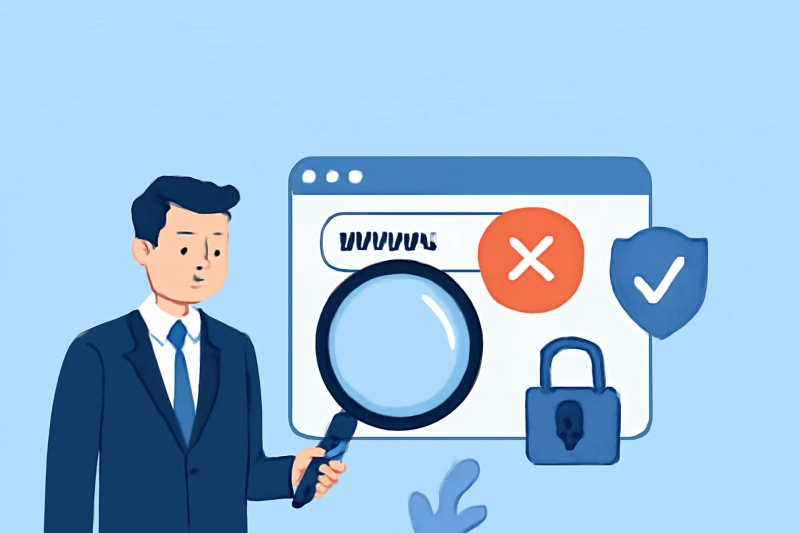In today’s digital age, the internet has become a vast and indispensable part of our lives. However, with the abundance of information and services available online, it’s also become a breeding ground for scams. One of the easiest ways scammers try to trick you is through fraudulent URLs. These fake links often look legitimate at first glance, but they can put your privacy, personal data, and even finances at risk. In this guide, we’ll explore how you can check if a URL is legitimate or a scam, and some key methods to protect yourself from falling victim to online fraud.
Why Is It Important to Check the Legitimacy of a URL?
Before diving into how to check if a URL is legitimate or a scam, it's crucial to understand why this is so important. Scammers use fake URLs to trick people into providing sensitive information like passwords, credit card numbers, or personal identification details. Once they get this information, they can use it to steal your identity, drain your bank account, or cause other forms of harm.
Additionally, some scams can trick you into downloading malicious software or visiting phishing websites designed to infect your devices with viruses or malware. These types of attacks can compromise your security, steal your data, and lead to significant losses in both your personal and professional life.
By learning how to check the legitimacy of a URL, you’ll be better equipped to protect yourself and your online presence from harmful attacks.
How to Identify a Scam URL: Key Red Flags to Look For
When you come across a suspicious URL, there are several red flags to look for. These can help you quickly identify whether the link is legitimate or a potential scam.
1. Check for HTTPS in the URL
One of the easiest ways to assess the legitimacy of a website is to look at the URL’s prefix. Legitimate websites often use "https://" instead of just "http://". The "s" stands for secure, meaning that the website encrypts your data to protect your privacy. Although not all scam websites avoid HTTPS, a lack of this feature should raise immediate concerns, especially if the website is asking for sensitive information.
2. Examine the Domain Name Closely
Scammers frequently use URLs that are designed to look like legitimate websites but with minor tweaks. For example, they might replace a letter with a similar-looking character or use a different top-level domain (TLD) like ".org" instead of ".com". Always scrutinize the domain name carefully. A slight variation can mean the difference between a trustworthy site and a phishing site.
For example, instead of "www.amazon.com", a scam website may use something like "www.amazon-secure.com" or "www.aamazon.com". If you see any unusual spelling or characters that don't belong, it’s a strong indication that the website may not be legitimate.
3. Check for Grammatical Errors or Typos
Legitimate websites usually take great care in maintaining high-quality content. If you see excessive typos, strange grammar, or awkward phrasing on a website, it’s likely a scam. Professional companies invest in proofreading and copy editing to ensure their websites are free of mistakes. Fraudulent websites, on the other hand, may not put as much effort into their content, which is why it's often riddled with errors.
4. Be Wary of Suspicious Pop-ups or Ads
If a website is asking you to download something, or if you notice an overwhelming amount of pop-up ads, you should be suspicious. Many scam websites use aggressive ads and pop-ups to trick you into downloading malware or signing up for fraudulent services. Always avoid clicking on these ads, as they might redirect you to malicious sites or install harmful software on your device.
5. Too Good to Be True Offers
Scammers often lure victims in with unbelievable deals or offers that seem too good to pass up. If a URL is leading you to a page that promises huge discounts, prizes, or unbelievable offers that don’t seem realistic, be cautious. Scammers prey on people's greed or desperation and often use enticing offers to bait individuals into providing personal information or money.
6. Verify Contact Information
A legitimate website usually provides clear and accessible contact details, including an email address, physical address, and phone number. If you come across a website that doesn’t list any form of contact information, or the contact information appears to be fake, that’s a significant warning sign that the website might not be trustworthy. If the website offers only a contact form and doesn’t provide any other method of reaching them, this could be another sign of a scam.
What to Do If You Suspect a URL is a Scam?
If you’ve come across a suspicious URL, there are several steps you can take to confirm whether the website is legitimate or a scam.
1. Check URL
A simple and effective way to verify a URL’s legitimacy is to use a URL checking tool. These tools can scan the website’s URL and provide a safety rating. By analyzing the domain and structure of the URL, these services can quickly determine if the site is a known scam or phishing site. You can use these tools to double-check URLs before clicking on them, making it an excellent first step in verifying the authenticity of a website.
2. Use a Search Engine to Look for Reviews
Search engines can also help you assess the reputation of a website. If the website is legitimate, you’ll likely find reviews or articles from trusted sources discussing it. On the other hand, if it’s a scam, you might find user complaints, warnings, or other resources that describe the website as fraudulent.
For example, you can search for the website name along with keywords like "scam", "review", or "warning" to see if others have reported suspicious activity related to that URL.
3. Use a Website Safety Checker
Some websites provide tools specifically designed to check the safety of a URL. These tools scan the URL for any known phishing activity, malware, or other harmful content. They can give you a detailed report on whether the website is safe to visit or if it should be avoided.
4. Look for Trust Seals
Legitimate websites often display trust seals from reputable companies that verify the website’s security and authenticity. For example, you might see a seal from a trusted security provider like Norton or McAfee. These seals indicate that the website has been tested and verified for security. However, keep in mind that scammers can sometimes fake trust seals, so it’s essential to verify these seals by clicking on them and ensuring they lead to the legitimate certification provider's website.
5. Don’t Provide Personal Information Without Checking
Never provide personal or financial information unless you’re certain the website is legitimate. If you have doubts about a URL, it’s better to be safe than sorry. Refrain from entering credit card details, passwords, or other sensitive information unless you’re confident the website is secure.
Additional Tips for Safe Browsing
1. Use Anti-virus Software
Installing reliable anti-virus software can provide an extra layer of protection when browsing online. This software can detect and block malicious websites or links that might attempt to steal your personal information.
2. Stay Up-to-Date with Browser Security
Ensure that your web browser is always up to date. Most modern browsers offer built-in protection that warns you about potentially unsafe sites. By keeping your browser updated, you’ll also benefit from the latest security patches and features.
3. Be Cautious with Public Wi-Fi
Avoid entering sensitive information when using public Wi-Fi networks. Scammers can use these networks to intercept your data, making it easier for them to steal personal information from unsuspecting users.
Conclusion
In today’s interconnected world, it’s essential to stay vigilant and protect yourself from scams that lurk online. By following the steps outlined above and learning how to check if a URL is legitimate or a scam, you’ll be better equipped to safeguard your online activities. Always check for HTTPS, examine the domain name closely, and be wary of suspicious offers or pop-ups. If you’re unsure about a URL, take the time to verify it using trusted tools before interacting with the website. By doing so, you can significantly reduce your risk of falling victim to scams and enjoy a safer online experience.
For a reliable way to check a URL’s legitimacy, visit https://phishs.com/.


